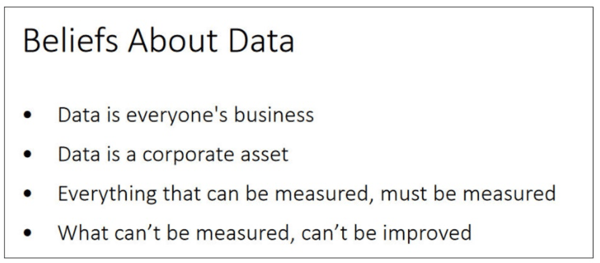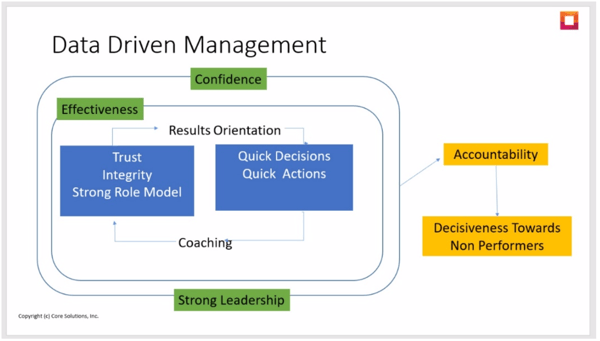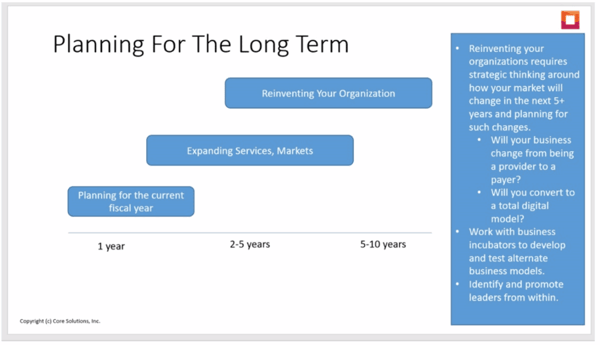Using Tech Tools To Build A High-Performing Organization
by Core Solutions on April 3, 2019

This blog post was originally written by By Sarah C. Threnhauser and published on www.openminds.com.
This year at the Kentucky Derby, the winner will walk away with a $1.8 million prize. The runner-up is looking at a $600,000 prize, and third place will walk away with $300,000. The difference between first, second, and third prize will likely be only milliseconds—and over a million dollars. In horse racing, first prize is only one that really matters. In health care, there’s a little more breathing room—but as the market changes, there is an increasing pressure to improve performance against the competition.
At last month’s OPEN MINDS Performance Management Institute, Ravi Ganesan, Chief Executive Officer of Core Solutions, Inc. used this horse racing analogy to illustrate why performance matters in a competitive market. Yesterday, Monica E. Oss took a deep dive into what constitutes a high-performing organization and how executive teams can determine whether your organization is high performing (see briefing—Is Your Organization ‘High Performing’?).
During his session, Utilizing Technology To Build A High Performance Organization In A Value-Based Environment, Mr. Ganesan explained that one powerful way to become a high-performing organization is to bend the power of technology to support organizational performance. As Mr. Ganesan noted, technology alone is not going to make organizations high performing. In today’s market, every organization needs to have technology. Simply having technology is no longer a differentiator—it all comes down to how an organization uses that technology to set their organization apart. The question is, how do you use technology tools to improve performance?

First, data-driven management is essential to all aspects of organizational performance. The first step is for executive teams to create a culture that appreciates data, is transparent with data, and makes decisions based on data. Performance data is a key organizational asset, and data literacy is a key management competency in high performing organizations.
Having access to financial and clinical performance data enables executives and managers at all levels of the organization to make data-driven decisions. When managers use data to make decisions, they become more effective, which breeds confidence, and helps to build accountability among the team and greater decisiveness towards non-performers.

Establishing metrics that are tied to strategy, easy to understand, actionable, and comparable, ensures that everyone within the organization is working towards the same goals. Progress can be made towards improving organizational performance if everyone knows the goals, understands how to achieve them, and is kept informed about progress and challenges along the way. As Mr. Ganesan said, “Knowledge isn’t power. Sharing knowledge is power.” An action-oriented organization is a data-centric organization.
Second, plan for the long-term by positioning your organization’s consumer treatment technology to compete. Digital health care is quickly becoming part of the care continuum for complex consumers. A wide range of tech-enabled treatment—from telehealth and remote monitoring, to online therapy and mobile engagement applications—is quickly morphing from concept to standard practice. As executive teams look ahead to positioning their organization for the future, there is a need to include some or all of these components as part of their strategy.

Request a demo of Core’s EHR platform today!
- April 2024 (2)
- March 2024 (4)
- February 2024 (1)
- October 2023 (3)
- September 2023 (3)
- August 2023 (2)
- June 2023 (2)
- May 2023 (3)
- April 2023 (4)
- March 2023 (2)
- November 2022 (3)
- October 2022 (1)
- September 2022 (1)
- August 2022 (3)
- July 2022 (1)
- June 2022 (1)
- January 2022 (2)
- December 2021 (1)
- October 2021 (2)
- September 2021 (2)
- August 2021 (2)
- July 2021 (5)
- June 2021 (5)
- March 2021 (2)
- January 2020 (3)
- November 2019 (3)
- October 2019 (2)
- July 2019 (1)
- June 2019 (1)
- May 2019 (1)
- April 2019 (3)
- October 2018 (1)
- September 2018 (1)
- August 2018 (1)
- July 2018 (1)
- June 2018 (1)
- May 2018 (2)
- April 2018 (1)
- March 2018 (1)
- December 2017 (1)
- October 2017 (2)
- September 2017 (1)
- June 2017 (2)
- May 2017 (2)
- April 2017 (1)
- February 2017 (2)
- January 2017 (3)
- November 2016 (2)
- October 2016 (3)
- September 2016 (2)
- August 2016 (1)
- July 2016 (2)
- June 2016 (1)
- May 2016 (3)
- April 2016 (2)
- March 2016 (2)
- February 2016 (2)
- January 2016 (3)
- December 2015 (2)
- November 2015 (4)
- October 2015 (3)
- September 2015 (4)
- August 2015 (1)


Let us know what you think